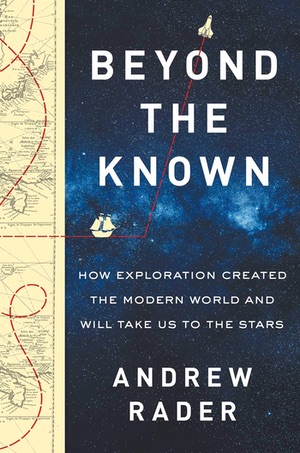Review: Beyond the Knownby Jeff Foust
|
| “After billions of years of evolution, we’re finally ready to leave our planet and see the universe for ourselves,” he concludes. |
Most of the book is historical. He recounts the early voyages of exploration, often by sea but in some cases over land as well, from antiquity to the modern era and from Europe to China to Polynesia. These chapters are largely a synthesis of existing research on those eras rather than new research; a “notes on sources” section at the end of the book shows he relied on a mix of popular accounts as well as academic papers.
It’s only relatively late in the book—more than 200 pages into a text that runs for about 300 pages, excluding sources and index—that Rader turns his attention to space, with chapters about the early Space Race and robotic exploration, then a forward-looking section on human exploration of the solar system and even interstellar flight. That includes an emphasis on Mars (the Moon, by contrast, “is much closer but also vastly inferior in long-term potential”) as one would expect from someone at SpaceX, but he also examines other destinations in the solar system and beyond.
“After billions of years of evolution, we’re finally ready to leave our planet and see the universe for ourselves,” he concludes near the end of the book. “The challenges we face today are no more daunting than they’ve been in the past, and the rewards no less meaningful.”
Yet, it’s not clear the book makes that case when it comes to human space exploration. Even the most extreme locations on the Earth visited by explorers in the past—the tops of the highest mountains, remote deserts, the poles—are paradise compared to the surface of Mars, with its tenuous atmosphere, cold temperatures, and lack of protection from radiation. Technology can address those, of course, but are the rewards worth the challenges? One theme from the book’s earlier chapters is how much trade and economics played in supporting earlier eras of exploration, but the business case for human spaceflight remains elusive. Rader describes the benefits of asteroid mining and even harvesting helium-3 in the long term, but even if those markets emerge some day, it’s not obvious they will require much, if any, human presence.
Perhaps the efforts of SpaceX, Blue Origin, and others will lower the cost of space access, particularly human spaceflight, to the point where some of the more speculative business cases will close. Or, perhaps, they can make it easier for exploration for other purposes, like science or national prestige, whose rewards would otherwise not be worth their expense. In any case, it’s clear space is the strongest test yet of the belief that exploration is part of our DNA.
Note: we are temporarily moderating all comments submitted to deal with a surge in spam.
